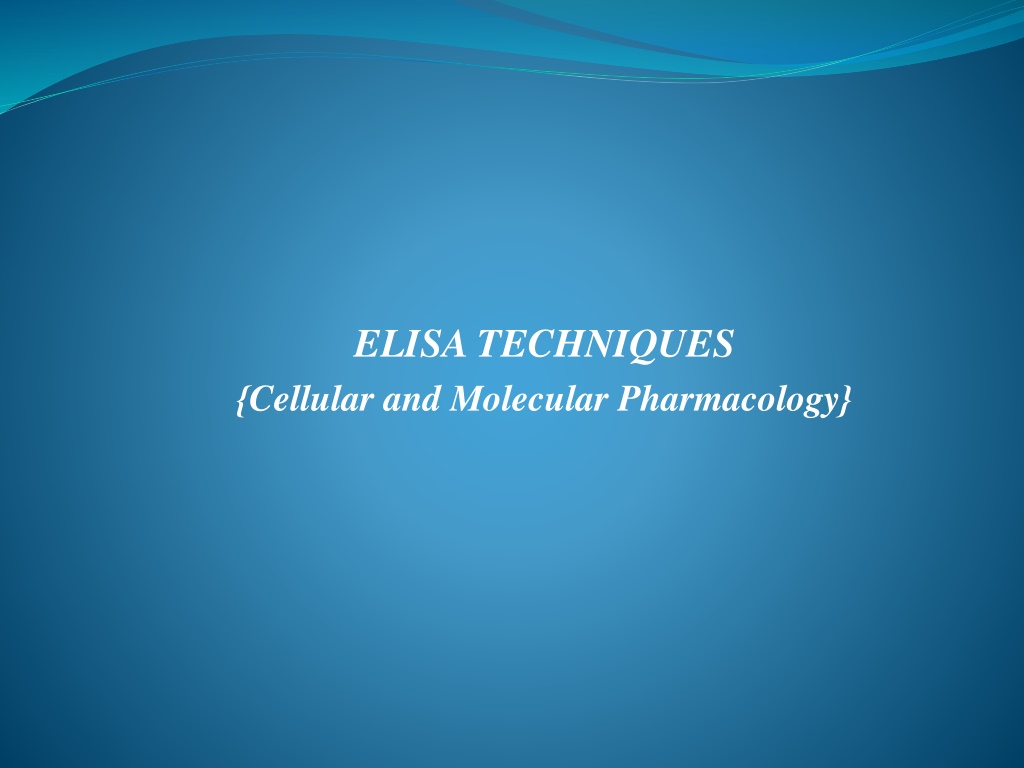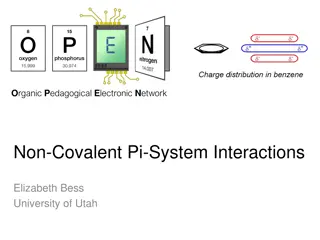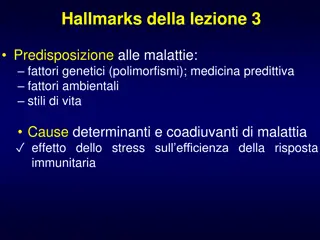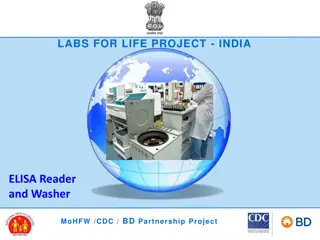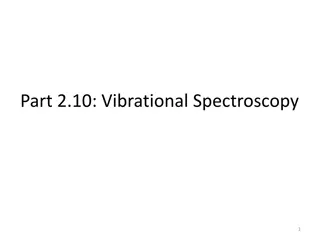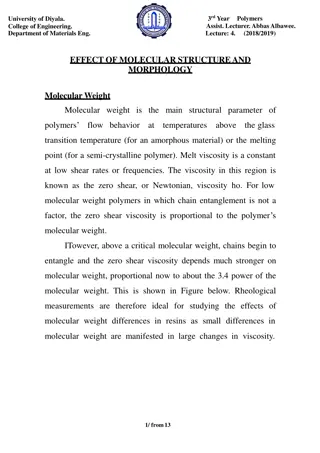Understanding ELISA Techniques in Cellular and Molecular Pharmacology
ELISA (Enzyme-Linked Immunosorbent Assay) is a vital immunological technique used in detecting antigens or antibodies in samples. This article covers the types of ELISA tests, such as Direct, Indirect, and Sandwich, along with the principles and applications of ELISA in diagnosis. The process involves coating plates with antigens, incubating samples, washing to remove unbound molecules, adding enzyme-linked antibodies, substrate addition for signal detection, and final analysis using a spectrophotometer. ELISA plays a crucial role in research and diagnostics within the field of Cellular and Molecular Pharmacology.
Download Presentation

Please find below an Image/Link to download the presentation.
The content on the website is provided AS IS for your information and personal use only. It may not be sold, licensed, or shared on other websites without obtaining consent from the author. Download presentation by click this link. If you encounter any issues during the download, it is possible that the publisher has removed the file from their server.
E N D
Presentation Transcript
ELISA TECHNIQUES {Cellular and Molecular Pharmacology}
CONTENT Introduction Types Principle Diagnosis Applications Advantages
ELISA ELISA stands for Enzyme-Linked Immuno sorbent Assay. ELISA is an immunological assay that is used to detect the presence of an antigen or antibody in a sample. It involves the use of an enzyme-linked antibody to detect the presence of a target molecule, such as a protein or hormone, in a sample.
Types Of ELISA ELISA tests can be classified into three types depending upon the different methods used for binding between antigen and antibodies, namely : Direct ELISA Test Indirect ELISA Test Sandwich ELISA Test
Direct ELISA Test The Direct ELISA technique is an immunoassay that is used to detect the presence of an antigen in a sample. It involves immobilizing an antigen onto a solid surface and then detecting the antigen with a specific antibody.
Plate Coating Antigen is immobilized onto a microplate well. Blocking Unoccupied binding sites on the plate are blocked with a blocking agent. Incubation Samples are added to the microplate and allowed to incubate.
Washing The plate is washed to remove any unbound sample. Detection An enzyme-linked antibody specific to the antigen is added to the plate. Washing The plate is washed to remove any unbound antibody Substrate addition A substrate is added to the plate that reacts with the enzyme to produce a detectable signal.
Signal detection The signal is detected using a spectrophotometer or other detection method
Indirect ELISA Test The Indirect ELISA technique is a type of enzyme-linked immuno sorbent assay that is used to detect the presence of antibodies in a sample. In an Indirect ELISA, a known antigen is immobilized on a solid surface, such as a microplate well. The sample containing the antibodies of interest is then added to the well, and any antibodies that bind to the antigen are detected using a secondary antibody that is specific to the primary antibody.
The secondary antibody is conjugated to an enzyme, such as horseradish per oxidase (HRP), which catalyzes a colorimetric reaction that produces a signal that can be measured using a spectrophotometer. The intensity of the signal is proportional to the amount of antibody in the sample .
Sandwich ELISA Test The Sandwich ELISA technique is a type of enzyme-linked immune sorbent assay that is used to detect the presence of antigens in a sample. In a Sandwich ELISA, a capture antibody is immobilized on a solid surface, such as a microplate well. The Sandwich ELISA is a highly sensitive and specific assay that is widely used in research and clinical application .
Principles ELISA works on the principle use an enzyme to detect the binding of Antigen {Ag} Antibody {Ab}. The enzyme converts a colourless substrate {chromogen} to a coloured produced , indicating the presence of Ag:Ab Binding . An ELISA can be used to detect either the presence of antigens or antibodies in a sample depending how the test is designed .
Diseases That Can Be Diagnosed Using ELISA ELISA can be used to detect some of these conditions: Ebola Pernicious anaemia AIDS Rotavirus Lyme disease Syphilis Toxoplasmosis Zika virus Carcinoma of the epithelial cells
Applications The ELISA technique has a wide range of applications in many fields, including: Medical diagnosis: ELISA is commonly used to detect the presence of infectious agents, such as viruses and bacteria, in patient samples. It is also used to diagnose autoimmune disorders, allergies, and cancer. Drug discovery: ELISA is used to screen large numbers of compounds for their ability to bind to a specific target, such as a protein or enzyme. Food safety: ELISA is used to detect the presence of contaminants, such as toxins and allergens, in food samples.
Environmental monitoring: ELISA is used to detect the Presence of pollutants, such as pesticides and heavy metals, in environmental samples. Veterinary medicine: ELISA is used to diagnose infectious diseases in animals, such as bovine spongiform encephalopathy (BSE) and avian influenza. Basic research: ELISA is used to study the function and interactions of proteins and other biomolecules in cells and tissues.
Advantages of ELISA The advantages of using ELISA in research and diagnostics: Sensitivity: ELISA is highly sensitive, capable of detecting even low levels of antigens or antibodies in a sample. Versatility: ELISA can be used to detect a wide range of analytes, including proteins, peptides, antibodies, hormones, and other biomolecules. Cost-effective: Compared to other sophisticated techniques like PCR or Western blotting, ELISA is relatively affordable and requires basic laboratory equipment.
Speed: ELISA offers a faster alternative to traditional methods, reducing the time required for analysis. Easy to perform: The ELISA procedure is relatively simple and can be performed with minimal specialized training. Clinical applications: ELISA plays a crucial role in medical diagnostics, such as detecting infectious diseases, autoimmune disorders, and monitoring therapeutic drug levels.
